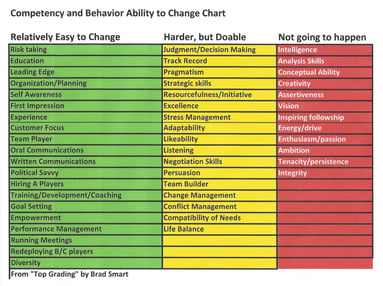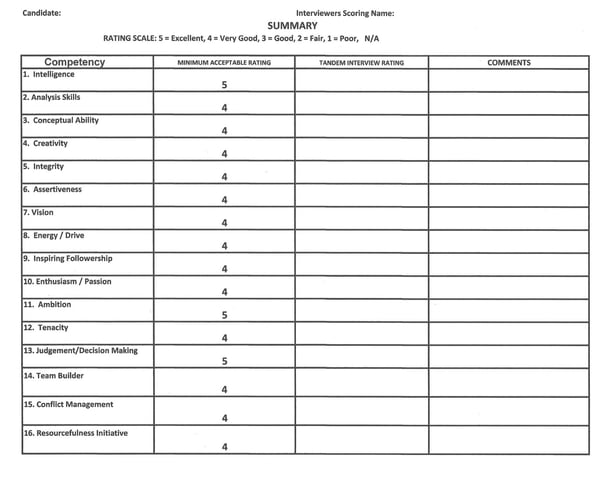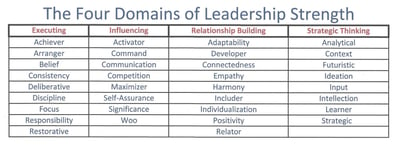In Take No Short Cuts to Hiring we looked at the process of recruiting and interviewing candidates for a Chief Operating Officer for one of my customers using the Topgrading Process.
We’ve gone through the short interview phase, just having completed the Core Competency Interviews. We will proceed with the CID interviews in October and early November. My customer has a deadline to hire someone for this position by the end of December so we’re in a good position to achieve this.
If you’d like a good primer on Topgrading, let me suggest checking out Summary of Key Concepts. If you scroll to the 4th page you will see a list of Competencies along with columns identifying which competencies are easy to change and which are difficult.  You can see a similar list depicted here in the picture.
You can see a similar list depicted here in the picture.
When you create your Job Summary Scorecard you want to identify a minimum of 12 – 15 competencies that you feel are critical for the person occupying this position. For a higher-level position, you should consider more competencies. Based on these competencies, identify those that are most difficult to change. These would be the ones to interview the candidate on.
In the case of Cornerstone Wealth Management Group, we identified 16 Core Competencies that occupied the Very Difficult to Change and Harder but doable columns focusing on the Very Difficult first.
We conducted two one-hour-plus interviews with each candidate asking one to several questions on each of the 16 Competencies. Here again, you can see some of the questions in Summary of Key Concepts which start at the bottom of page 4. There are 50 Core Competencies and this is a list of questions for each Core Competency.
It’s best to use a tandem interview process with each candidate. I was in charge of leading the questions, and two employees from Cornerstone Wealth Management Group joined me, one for each interview session to listen, take notes, ask clarifying questions, and score the candidates after each interview. We asked questions on 8 competencies in one interview. We'll ask 8 more in the next interview.
You want to complete the scoring as soon as you’ve completed the interview process so it remains fresh in your mind. You should determine your acceptable minimum rating for each competency before the competency interview.  An example of our scoring sheet is provided here.
An example of our scoring sheet is provided here.
The comment section is important. When I completed my comments I included questions I had that I didn’t feel the candidate completely answered to follow up with these in the CID’s interview. Comments are also critical to the person included in the CID’s (Chronological In-Depth Structured) interview. In this case, Scott Ford the CEO will conduct the CID’s interview with me as we proceed with these two very qualified candidates. Having good notes for him to review prepares him to know the candidates better and primes him for good follow-up questions and what to explore in areas that might require more discovery.
One of my radio station partners always offered this to the candidate we would interview: “We all have our strengths and weaknesses. We'll find those out when you join us if you’re the person we hire. It would be better to be aware and be prepared for them before you are hired so we both know what to expect.”
There’s nothing worse than being blindsided by someone you hired, learning too late that they were poor at some function that is critical and which needs an A Player to navigate successfully. Many times it’s not that one person is so much better than another, it’s how they fit with the strengths and weaknesses of your current team. If they mesh well, weaknesses are covered by someone who has this as a strength, and very often the new employee can cover for a weakness on the team that they have as a strength.
 In Gallup’s Strength Based Leadership, they note there is no one grouping of leadership skills required for great leadership. Rather the key for a leader is to identify your strengths, and those of your key leadership team, and fuse them to get results.
In Gallup’s Strength Based Leadership, they note there is no one grouping of leadership skills required for great leadership. Rather the key for a leader is to identify your strengths, and those of your key leadership team, and fuse them to get results.
Our two candidates scored at or above the minimum level for our Core Competency questions. We’re moving on to the CID’s interviews. More progress on the outcome in a future blog.
In two weeks a group of former Pro Football Players from SportsWorld will be in Cedar Rapids to present a topic based on their personal experience in making good choices. The theme of each of their presentations is, “You were not born a winner or a loser you were born a chooser.”
Your business is about to make critical decisions on your direction for the year ahead. How prepared are you? We’ll explore planning for this and making good choices next blog. If you have questions or concerns for your business planning consider attending our November 11th Scaling Up Workshop in Cedar Rapids, IA.






.jpeg?width=150&height=135&name=Hand%20with%20marker%20writing%20the%20question%20Whats%20Next_%20(1).jpeg)

